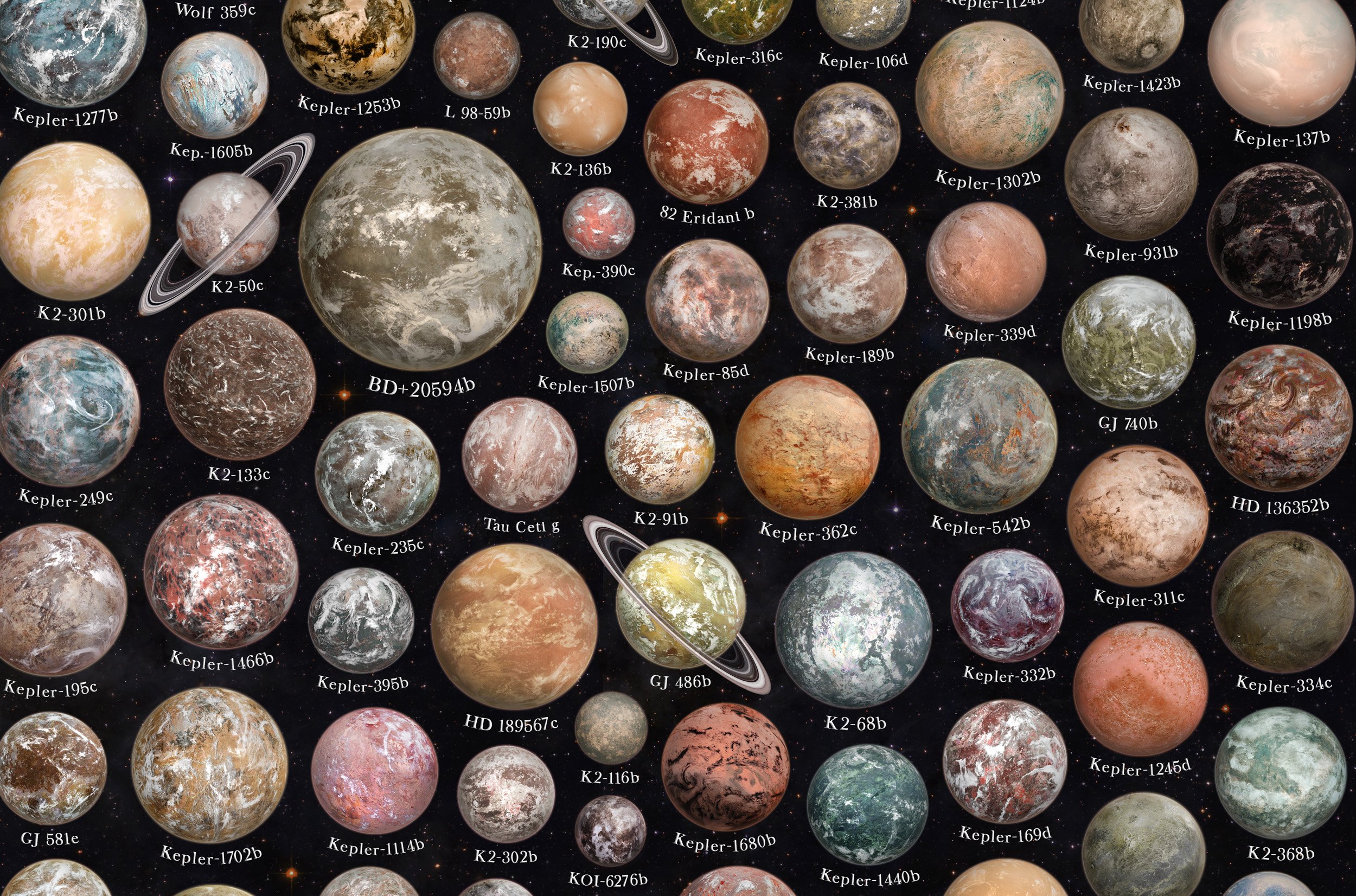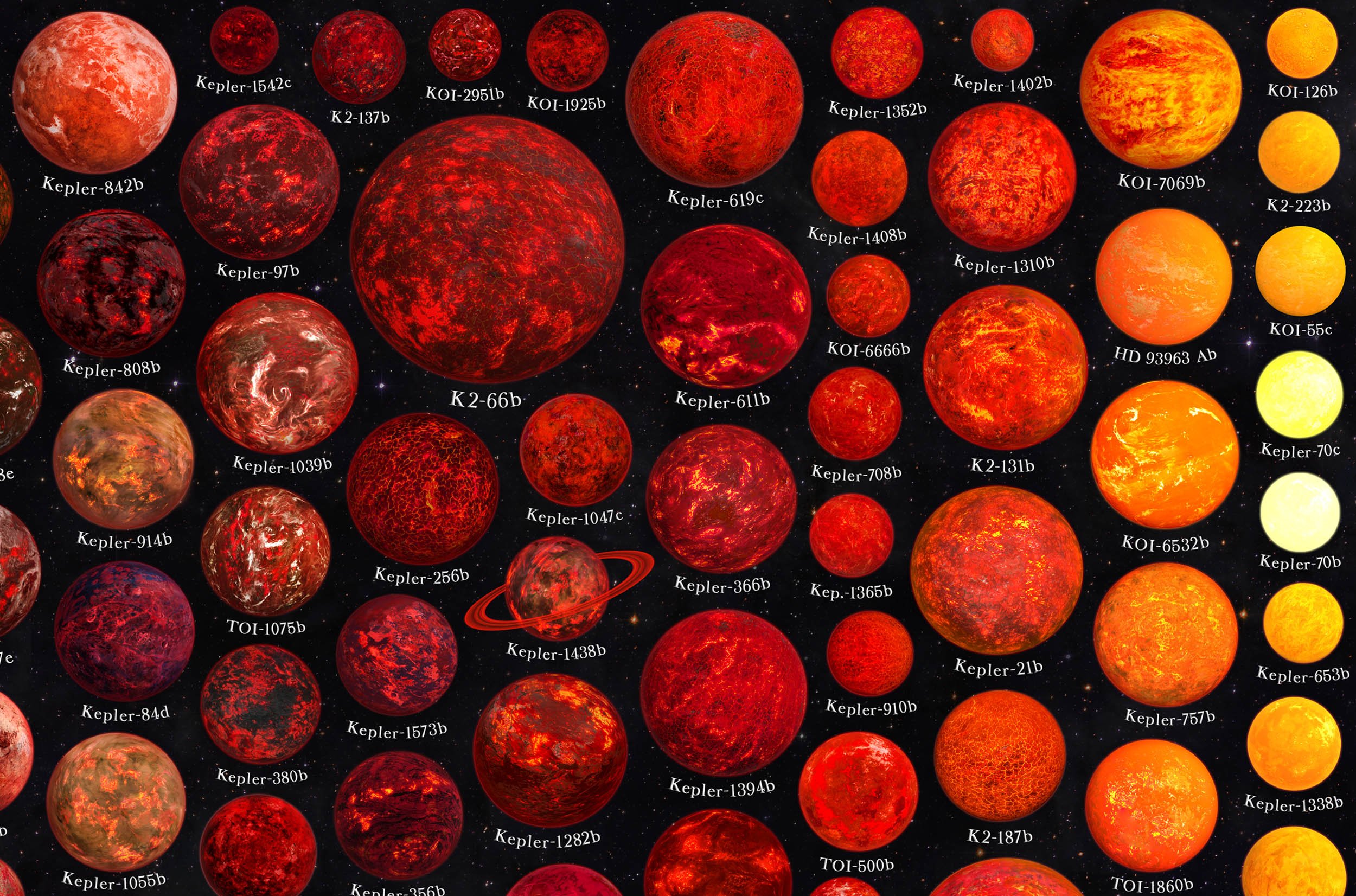ICY AND ROCKY exoplanets
SEE THE INFOGRAPHIC IN A HIGH RESOLUTION HERE!
Since the discovery of first known exoplanets in 1992, orbiting the pulsar PSR 1257+12, we have found and confirmed over 6140 distinct and diverse worlds in more than 4500 star systems throughout our galaxy.
They can be broadly divided into gas giants similar to Jupiter or Saturn, ice giants such as Neptune, and rocky planets like Mercury, Venus and Earth, some of which might be conductive to life.
However, not all of them are similar to planets found in our own solar system; we have discovered many diverse exotic worlds such as hot jupiters with clouds of molten rock, water worlds covered by a world-spanning unfathomably deep superocean, red-hot lava planets or planets darker than coal.
With the help of scientific models and up-to-date information, this poster attempts to artistically visualize together almost 900 of known exoplanets that are or could be rocky or terrestrial, arranged by the amount of heat they receive from their stars, comparing their estimated sizes and providing a window to how they might look like.
Our telescopes are not yet powerful and advanced enough to directly image the surface details of small exoplanets, so this infographic cannot show their actual appearance and what’s shown are artistic approximations.
There are uncertainities in data for the mass and radii of many exoplanets, so for many planets, their portrayed sizes are not exact and might be subject to update when new data comes out. Some of the planets shown on this graphic might even turn out to be just artifacts of stellar activity, and not exist at all, such as the planet Kapteyn b.
Using methods such as doppler spectroscopy, microlensing and transit photometry, we are able to estimate dimensions and mass of many planets with considerable accuracy, as well as calculate the amount of heat that reaches them from their star
Kepler Space Telescope in particular has provided the most valuable and accurate data.
Planets with a radius below 1.6 times of Earth are likely to be terrestrial planets with an interior made mostly of rock and metal, most of which having a solid surface. Beyond this point, planets are likely to accumulate more and more gases, eventually becoming more similar to a hot versions of uranus with a gaseous atmosphere seamlessly transitioning into a liquid mantle.
Most terrestrial planets known belong to a class of “super-earths“, up to several times more massive than our planet.
The coldest terrestrial worlds would be covered with an crust of various ices, including water ice, dry ice, methane or even solid nitrogen. With a sufficiently thick atmosphere of nitrogen, methane or ammonia, cold terrestrial planets might possess lakes and rivers of liquid ammonia or various hydrocarbons, just like Saturn’s moon Titan. They could possess a subsurface liquid water ocean, where life might arise near hydrothermal vents.
Exotic icy worlds could feature cryogenic clouds and rain made of liquid nitrogen, neon, carbon monoxide or oxygen.
Above an equilibrium temperature of -100 C, given sufficiently thick atmosphere, planets could already possess lakes or oceans of liquid water, making them potentially habitable. Some exoplanets could be entirely covered with liquid water, forming a global ocean tens of kilometers deep.
As the first lifeforms developed on Earth very soon after its formation, it’s likely that many planets in the habitable zone might possess at least primitive single-celled life.
The longer a planet spent in the habitable zone after its formation, there is a higher likelihood of complex life on its surface. Many planets orbiting red dwarf stars, such as the TRAPPIST system, could remain habitable for hundreds of billions of years into the future, although higher stellar activity and flaring of many such stars might make it difficult.
It has been calculated there are almost 9 billion earth-sized planets within their star’s habitable zone just in our own galaxy, more than one such planet for every living person!
At the inner edge of the habitable zone, planets with an equilibrium temperature over 40 C are likely to undergo a runaway greenhouse effect. All of their water would evaporate into the atmosphere as steam, causing temperatures on the planet’s surface to rise to unhospitable levels.
Many of these planets would eventually end up like venus; all the hydrogen from their steam atmosphere blown away by the solar wind, leaving a dry, hot atmosphere of carbon dioxide and nitrogen. Clouds on these planets would likely be composed of sulfuric acid and other sulfur componuds, just like on Venus.
As planets get hotter, it is increasingly more difficult to retain an atmosphere due to stellar wind and heat. Small rocky planets would likely have most of their atmospheres blown away and so would be bare, grey and rocky.
However, large enough planets, could still have an atmosphere, with hazes of soot and clouds made of various sulfur compounds, chlorides or even molten salt.
Planets warmer than 800 C are hot enough to visibly radiate a dull red color. At even higher temperatures, the sheer heat combined with tidal effects would melt parts of the planets surface, creating lakes and oceans of lava.
The hottest rocky planets might be entirely molten, with clouds and rain made of silicates, molten glass, or even corundum and iron.
Planets close to their parent star are likely to be tidally locked, just like the Moon is to Earth. One side of the planet would perpetually face the star, with the other one shrouded in permanent darkness
Let's look at some of the more interesting exoplanets out of the many hundreds that can be found on the poster!
TRAPPIST-1b is one of eight planets that orbit around a very small and dim red dwarf star. All planets in the system are likely to be terrestrial, 3 of them lying in the habitable zone. All of them would fit well within the orbit of Mercury, and planets come so close to each other that neighboring planets can appear as big and bright in the night sky as our moon.
Proxima B - a terrestrial exoplanet slightly bigger than the Earth, located in the habitable zone of Proxima Centauri, the nearest star to the solar system at 4.25 light years away. In the future, it is likely to be the first exoplanet we send a probe to. Using the Orion drive, designed to accelerate a spacecraft by continuously detonating thousands of thermonuclear bombs behind it, such a journey might take less then a century.
Kepler-1652b - A super-earth orbiting within the habitable zone of a red dwarf star, receiving 80% of the sunlight Earth does. It is almost certainly tidally locked, with one side perpetually facing its star and the other in permanent darkness, making it a possible “eyeball planet“, with its dark side covered in ice and the other in an ocean of water
Kepler-277c - one of if not the largest known planets likely to be rocky, and at the maximum mathematical size limit of how large any terrestrial planet can possibly get. Any added mass would actually cause the planet to shrink in size, as the sheer pressure in its core would force atoms closer together.
Kepler-277b - a "mega-earth" mostly rocky planet even heavier and denser than Kepler-277c. It is almost as massive as Saturn, its sheer mass causing it to contract inwards. It likely has a solid surface and its surface gravity is crushingly powerful - over 10 times stronger than Earth's.
55 Cancri e - planet with a confirmed lava ocean covering all of its surface. The planets interior is likely to be heavily composed of carbon, most of which is in the form of diamond
Kepler-70b - Possibly the hottest exoplanet known, with its surface hotter than the surface of the Sun. Originally, it might have been a gas giant that had all of its gases stripped away by its star, leaving only a rock and metal core. The planet will eventually be completely vaporized by the heat of its star
Ring systems on the infographic are an artistic addition. It is not inconceivable that many rocky planets in the galaxy might have a ring system. Mars itself will have a ring system of its own in the future, when its moon Phobos spirals too close to the planet.
Data about the sizes and equilibrium temperatures of hundreds of exoplanets was gathered from The Extrasolar Planet Encyclopaedia, NASA Exoplanet Archive and ExoKyoto








